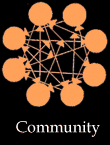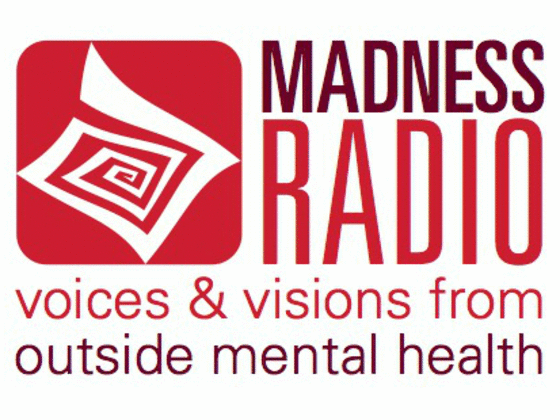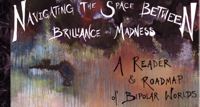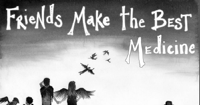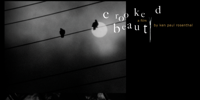Bay Area Icarus Hosts Community Discussion: An Integrative Approach to Madness
Submitted by Icarus Project on Sat, 10/22/2011 - 3:13pmBelow is a transcript from Icarus member Danni Biondini from our event at CIIS the other night with Michael Cornwall. It was a pretty awesome and timely discussion with multi-generations represented in the crowd of about thirty people on a Monday evening. Michael held the space and used his 30 years of experience in the system to break down the situation and then open it up for a series of questions. There is a group of us, inspired by Michael and his decades of experience withing with people in psychotic process, that is talking about opening up a a holistic Berkeley drop-in healing center. This was the first time a group of people in the Bay Area were getting together and discussing this project, and it was powerful that, amongst the younger generation of Icaristas, there were a number of people there who had put years of their lives into working on projects such as Diabasis House, Soteria House, I-Ward, and the Spiritual Emergency Network.

An Integrative Approach to Madness: A Conversation with Michael Cornwall
Monday, October 17th 7 to 9pm Room 607 at CIIS (1453 Mission St. San Francisco)
Come be part of a freewheeling conversation with Michael Cornwall Ph.D., as we explore an expanded meaning of transformative madness and how to lovingly serve those who are in a madness/psychosis process. Plus, we will shares ideas for creating a new space or sanctuary that supports people working through this process.
Michael Cornwall received his Ph.D. from CIIS and has specialized for 30 years in Neo-Jungian psychotherapy with people in a psychotic process, without medications. For several years he worked in 24/7, medication free, acute psychosis sanctuaries. He also served in children and adult clinical programs for acute and long term psychotic clients. He completed Doctoral research on the Jungian sanctuary Diabasis House.
A link to Michael's handout An Integrative Approach To Transformative Madness



An Integrative Approach to Madness with Michael Cornwall
Oct. 17, 2011
Thanks for coming to this conversation about what we can do if we’re mad, or our friends are, or our loved ones. Christine Price, the co-founder of Esalen, told Michael he needed to meet Sascha, and the new generation of young firebrands.
History of alternative services in the Bay Area. What it’s like to be in a 20-bed place where there are no medications, no restraints. In the first hour of crisis, they call one of us to come down and be there.
A central question: If madness isn’t what biopsychiatry says it is, what is it? If we don’t agree with what biopsychiatry says, then we probably don’t agree with the treatment practices. For us to have some kind of intelligible answer to a first-year psychiatry intern who can tell you: it’s a brain disorder and every minute that it’s not being medicated, there’s irreparable damage being done. The people who fund the research are the big phama companies that psychiatry represents. A psychiatrist now can see 30-40 clients a day. Psychiatry says: this group of Icarus folks can sing Kumbaya all you want, but we own it. I don’t believe that.
Robert Whitaker’s book Anatomy of an Epidemic. With Whitaker’s book comin out, in the last year and a half, I’m seeing signs that there really is a chance to move things forward. Sometimes thousands of people will show up to hear him talk. There’s an audience now, not just cause of the work he’s done, but the work we’re doing. There’s a chance for things to shift. Some of the top companies in BigPharma have decided to no longer to research and testing on psych drugs in the past few months. They see this tide of public opinion. The NY Times Book Review wrote up Whitaker’s book, excoriating psychiatry.
When the first SSRIs came on the scene, they found the chemical imbalance in the brain. Well, that’s not true. Psychiatrists told Whitaker: we abandoned the chemical imbalance theory of depression twenty years ago. Well, you might have told the public!
Dr. Joseph Beiderman, the top child psychiatrist in the country, got a slap on the wrist. But he’s toast. He created this false child bipolar epidemic. Now he’s been chastised before Congress. On the cover of Newsweek is a child going, “Am I bipolar mommy?”
50% of children on SSRI have a mental illness diagnosis. Children under 2 are routinely given Abilify, a powerful anti-psychotic, for insomnia.
Another logical extension of this model: if a child is tearful and sad and won’t sleep, they should be strapped down and have electrodes put on their heads and given ECT. That is happening to toddlers in Australia.
Teens with zero psychotic symptoms are now considered to have pre-schizophrenic syndrome if one of their parents is psychotic. They are put on medication so they don’t develop psychosis. In 47 states, Assertive Community Treatment is the law of the land. If you get out of the hospital, you’re court-ordered to take medication, and if you don’t, you’re back in the hospital. Not in California. It’s a project of the National Alliance of the Mentally Ill. They’ve done incredible damage. 40 years ago, when doing therapy in Contra Costa County, NAMI got the Bronson legislation passed so that the only money for “serious mental illness” would go for case management and medication, no more therapy.
NAMI started printed glossy flyers in all the childrens’ clinics that said, “only a child psychiatrist can diagnosis your child, because they have a brain disease.” (Danni adds: who has the brain disease, the child or the psychiatrist?)
Soldiers are on all these anti-psychotic meds. They had their own internal review of soldiers who have insomnia, and ruled they will give them anti-psychotic medications for their insomnia.
The FDA approved that dogs now can be prescribed Prozac because they have canine separation anxiety when you go away.
Wealthy people in North Carolina run CooperRiis, an alternative program. Formed alternative thinktank to challenge this. Started parent support group to challenge the NAMI thing.
New York is opening more respite houses, and even getting a green light to open some Soteria houses.
The Icarus Project has more than 10,000 members.
Forbes magazine advised investors to back out of pharma companies that are big on psych drugs.
To me, the whole question of: if madness isn’t what biopsychiatry says it is… really was best established by the largest National Institute of Mental Health study done in the 1970s: a govt-funded program in a state hospital with 100 young first break psychotic males, who got placebo, and the other group got thorazine. The people who got the Thorazine, because it knocks down the emotional inner life, their symptoms were reduced. (Now psychiatry would say it’s also that their brain is not swelling). But the people not given meds had 80% lower re-hospitalization a year later.
Diabasis House on Pine St. was a six bed sanctuary where people went through their psychotic process unmedicated. People who got that loving support and care through their process had 80% lower rate of being in the hospital. Willie Brown said: I think this will save us a lot of money!
I-Ward was freestanding, open ward, no diagnosis, no medication place. People went through their process and came out on the other side weller than well. When you have a ward wth six people in full-blown process, not everyone can handle it. After about a week, they said, you can do the work.
John Perry outlined the archetypal fact that everybody in a psychotic process is in an archetypal process. Michael’s first client had ecstatic light in one hand, and darkness in the other. A lot of times the person in this leaving-home psychosis has to go through this process. The family hasn’t provided the development that they need, and they may hit Stanford or the Army, and they just go under. She went through this whole thing of light and dark, male and female, good and evil, the Madonna. At Diabasis they just said: this archetypal process will carry you through. The key is to have one person is the loving other part of the dyad. The psyche needs this t create a space where the psyche can integrate.
In my 20s, I went through it alone at my grandma’s house, in this environment of unconditional love. Mine was all dark, it was all hell, and it was really scary and terrifying. Some people go up, some have both. Some it’s more of a soul journey than a spirit journey.
There’s this existential kind of place that happens, or almost like an ontological terror about what’s going to happen to me in my life. Am I going to be able to make it? Am I gonna be able to be what my parents have set out for me? I was gonna go to law school!
At I-Ward, we didn’t use restraints, we would hold people. Sometimes three or four people would hold them, sometimes for hours. Then they would start crying, and we’d hold them, and it was like some early Object Relations thing, that bonding. We all need that when we’re suffering, when we’re afraid, when we’re sick.
Loren Mosher led Soteria House. It doesn’t matter if you do the archetypal thing, or the family therapy thing, or the Laingian thing. You don’t have to have an MA. Diabasis was staffed by para-professionals. They’ve been psychotic, or they’ve taken LSD, and they’re comfortable with people.
We’re hard-wired mammals and when we go mad, we need someone to love us.
What does it mean if you take 100 young men and they get a chance to “get it all out” at I-Ward? That means 80% won’t be in the system. If you put them on meds, 80% of them will still be on meds.
Twin studies in Scandanavia based on moms who are schizophrenic: Object relations begin at conception. They have a relationship with their mother in the womb.
During the six day war (in Israel), women in their second month of pregnancy, when their children grew to young adults, there was a huge spike in them being schizophrenic. If there’s any kind of trauma…
The mood of the mother during pregnancy effect the child, in the first 9 months.
“Every minute that psychotic brain isn’t being medicated, they’re being harmed.” Psychiatrists believe that.
The NIMH study: by Silverman & Rappaport in the Journal of Psychopharmacology. Tried to get that study released in the top journals in the country and it was suppressed.
A young physician read Whitaker’s book, and had a crisis of conscience, started writing on Whitaker’s blog, saying maybe we should look at Whitaker’s work, and it wasn’t long before he was fired. It’s destroyed people.
Loren Mosher wrote a letter to the American Psychiatric Association, talked about how he’d been banished by any kind of mainstream stuff. Finally got a job in Vermont, and people tried to get him fired.
Daniel Fisher, went through psychosis, and then became psychiatrist. Michael put down $250,000 for first break crisis house in Contra Costa County, and the NIMBY-ism began.
Jacks: seems like a lot of the analysis is based on first-break psychosis. What about people in second- or third- break? There’s all these miracle stories of people who were 19 and had their first break.
Michael: 50% of folks diagnosed with Axis I mental disorder were not taking their meds. A lot of the “chronic people” were referred to me. One guy, his presentation was the negative, chronic symptom of flat affect, no speech, no delusions, no voices. He went through I-Ward. I started seeing him again. Started doing Jungian dream work with him, and found that even for people who’ve been on medication, with the somatic work or dreamwork, there’s a way to re-animate the emotional engine that drives psychosis. Through the dreamwork, that happened with him. All these emotions that he and his family had never been able to express came up in the dreams. A lot of guilt. Then he went through a rage phase. Each one of these emotions that he used to get psychotic behind, if he got too interested in a girl, he’d get spun out. Took him to lunch where all the girls were. After years of working with him, he’d experience the affect in real life and wouldn’t get psychotic behind it. He could say, “Yeah, the boss was an asshole today but I didn’t lose it.”
It’s not a broken mind, it’s a broken heart. Finally, he said, “you know what my mom said to me when I was young? She wished she wrapped me up in newspaper and three mw out”
That somatic work is another way to really help people. It’s the affect that come up and it’s overwhelming. The psyche has to give some symbolic meaning to those overwhelming emotions.
Jacks: are they working during that? are they on SSI? A lot of people don’t want to go into a two-year healing crisis, because they don’t want to lose their jobs, or their relationship. So instead they take Seroquel. What kind of support is needed for folks to go through these psychotic processes?
Michael: I never try to talk anybody out of taking meds. There need to be places where there is a holistic place where people can get massage and yoga and dreamwork and 12-step meeting and all kinds of good food stuff. These healing centers need to be out there. Gonna take part of his retirement and build a storefront in Berkeley.
Zoe: what about people who don’t have SSI, don’t have the safety net, etc? Michael: for a few years worked on mobile outreach. A place in the Tenderloin called the Faithful Fools cause poverty’s not going away. Somebody needs to sit down and think through this question.
Zoe: I trained with John and Stan Grof, and would stay with people wherever they were. A lot of times they would lose their jobs, and would come and move in to ten-acre house in the country. Had a community of people they would rotate. It was hard working a full-time job in crisis, then coming home to work with people in crisis, which is where our hearts were. It was the financial strain that got us finally. We burned out.
John Perry said: don’t try to do another Diabasis or Soteria. Go out and see if you can find people who can pay 10-20,000/a year as philanthropy.
Q: how long can people be medicated and still be retrieved? Somebody said: up to about 5 years.
Madness is a mystery. It’s not what we decided it is.
Q: how are we creating different landscapes and how are they sustainable? A lot of good models come from indigenous models with people who live in collectives. It’s recognized as a spiritual emergency. A lot of people with licenses don’t know that this kind of work is possible.
The whole question of spiritual emergency. Have a problem with people separating out that some are in a process of spiritual emergency. It seems elitist. Doesn’t believe in distinguishing between someone in an archetypal process cause they’re 20 years old, vs. someone who is 50 yrs old and in the system for 20 years. It doesn’t mean that the people who are 50 years old aren’t in an archetypal process, as well.
Comment: if you take the Seroquel, your world will fall apart even worse. They never tell you that if you take anti-psychotics long enough, you will become psychotic. SSI for mental health issues is the equivalent of unemployment insurance.
Are we a community? What would it be like if somebody gave us a 100 acres in Marin?
The Foundation for Excellence in Mental Health Care – probably the foundation that wants to give people money.
On I-Ward, didn’t have a research component. Didn’t feel good about that. though nobody knows about it, even though it lasted 8 years. Once you start down the road that we need to prove the efficaciousness, we start playing the biomedical game. It’s somehow dehumanizing when you measure people.
You can get acupuncture as part of insurance now, because people wanted it.
The psychiatrists don’t care about the studies.
David: some people are able to be good clinicians and good researchers, too. Spent some time working at Soteria. One of the things that stopped people from going back into the hospital, is once you left the house, there were lots of different places to live, but the house would become their community, and they could move back in for a few days. All of us need a place to feel safe at times.
David: I’ve been part of the mental health system for 18 years and it’s such a monolithic, unassailable model to even dream about questioning it is to bring sanction to yourself. There’s so much research available about what people are doing all over the world. It’s giving me hope. The pharmaceutical companies control the research. There’s so much going on in the world. The value of research is knowing that it’s being done. In Santa Cruz, a diversion program for people instead of being 51-50ed. Whatever else is going for them somehow melts away. It has to do with love: has to do with allowing and not controlling.
Q: How do you work with somebody who is on meds?
Michael: I don’t ever tell people to get off meds. But if you hear the slightest opening or questioning… The Icarus Project made one of the best harm reduction guides for getting off meds.
Jacks: Look at the parts of the therapeutic relationship that’s not about transformation. Look at building connection, building allyship, etc. Sometimes meds can really help people keep from blowing their top off. Having someone go off their meds too quickly, and if they don’t have their support net, is a really bad idea. I think it’s a fallacy that you can’t work with someone until they’re off meds.
Q: I run a website called coming offantidepressants.org, focusing on the big middle that doesn’t need residential or intensive support. Trying to recruit doctors like Mark Foster who will work with patients to gradually taper them off medication. The advice is always extremely gradual titration. Few doctors understand what gradual tapering means. Antidepressants are the gateway drug to more serious drugs.
Ads on TV for Abilify: is your anti-depressant not working well enough? Let’s add an anti-psychotic.
Sascha: Started Icarus not knowing anything about the history of the Survivor Moment. When we stumbled on the history of the Human Potential Movement, it was a revelation. And where did it all go? One, 1980 the DSM-III comes out and crushes all of it. But also a lot of projects imploded in on themselves. How do we not make the same stupid mistakes again?
Michael: a lot of it was naked idealism that we can keep running this ship, and get federal funding. There were people, John Perry got kicked out of the Jung institute for having sex with his patients, RD Laing lost his medical license for throwing a whiskey bottle. People who got in there and fucked it up big time set it back years. If you’re gonna do it under the auspices of any federal money, you’re gonna regret it.
Zoe: develop a strategic plan. Something that is really systemic, so you have a really good foundation, a method of training the right people to do the work. There was belief that if we just put out heart and soul in it, it would take care of itself - that’s when you burn out. Accessibility is really important. Being close to the city is one of the most important things you can do.
If there is any grand plan, it needs to involve money.
Windhorse is successful. It is sooo expensive. CooperRiis is $14,000/month.
If psychiatry ever looked at anything having to do with trauma or culture, it would almost turn everything on its head.
Q: is there training for law enforcement? Michael: our program had a lot of outreach and connection with local law enforcement. You have to do a lot of outreach and make friends with the cops, and say we’re here to provide a real service.
Q: at Progress Foundation, they seem to provide both sides, where you can taper off your meds or leave anytime you want. Michael: it’s been a good program, but they’ve never had a front-end, diversion program. That’s the missing piece. Q: that’s not what I experience working there, not what I experience from our admin. Med compliance is one of the assessments. If somebody’s not taking their meds for 3 days, you have to tell the admin. The money comes from the fed, the state, and the county. Generally, everyone’s on Risperdal or Seroquel and it’s a problem if they’re not.
Final words: Keep in touch. This is a community effort. God bless Icarus and CIIS.



